

Yehong Wang, Mi Peng, Jian Zhang, Zhixin Zhang, Jinghua An, Shuyan Du, Hongyu An, Fengtao Fan, Xi Liu, Peng Zhai, Ding Ma*, Feng Wang*
Nat. Commun., 2018, 9, 5183
Selective conversion of an aqueous solution of mixed oxygenates produced by biomass fermentation to a value-added single product is pivotal for commercially viable biomass utilization. However, the efficiency and selectivity of the transformation remains a great challenge. Herein, we present a strategy capable of transforming ~70% of carbon in an aqueous fermentation mixture (ABE: acetone–butanol–ethanol–water) to 4-heptanone (4-HPO), catalyzed by tin-doped ceria (Sn-ceria), with a selectivity aas high as 86%. Water (up to 27 wt%), detrimental to the reported catalysts for ABE conversion, was beneficial for producing 4-HPO, highlighting the feasibility of the current reaction system. In a 300 h continuous reaction over 2 wt% Sn-ceria catalyst, the average 4-HPO selectivity is maintained at 85% with 50% conversion and > 90% carbon balance. This strategy offers a route for highly efficient organic-carbon utilization, which can potentially integrate biological and
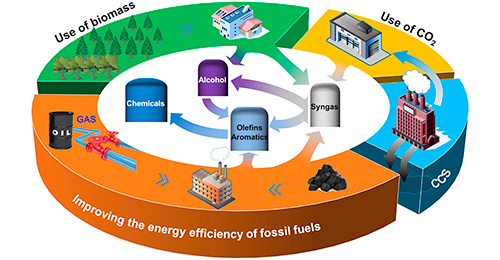
Zhitong Zhao, Katie Chong, Jingyang Jiang, Karen Wilson, Xiaochen Zhang, Feng Wang*
Renew. Sustain. Energy Rev., 2018, 97, 580-591
The increasing emissions of carbon dioxide (CO2) are primarily driven by the rapid expansion of energy-intensive sectors such as the chemical industry. This work selects ethylene, one of the most important chemicals, as a model study to represent the low-carbon roadmap of chemical production. Four strategies improving the efficiency of fossil resource usage, developing the technology for carbon capture and storage (CCS), CO2 chemical conversion, and converting biomass resources into chemicals, are used to reduce CO2 emissions. A comprehensive analysis of the life cycle CO2 emissions of different ethylene production routes has been performed to compare their emission reduction potential. The results indicate that the BMTO (biomass to olefins via methanol-to-olefins) pathway releases the least CO2 (− 1.3 t CO2/t ethylene)
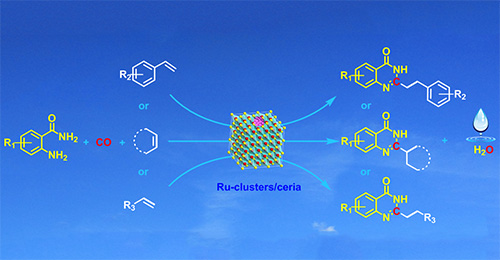
Jinghua An, Yehong Wang, Zhixin Zhang, Zhitong Zhao, Jian Zhang, Feng Wang*
Angew. Chem. Int. Ed., 2018, 57(38), 12308-12312
Quinazolinones, an important class of heterocyclic compounds, have been widely used in pharmaceuticals because of their biological activity. However, the efficient and economical synthesis of quinazolinones has remained a challenge. A novel synthetic approach has now been developed to produce quinazolinones from olefins, CO, and amines over heterogeneous Ru‐clusters/ceria catalyst in the absence of acids, bases, and oxidants. Furthermore, H2O is generated as the only by‐product. A series of quinazolinones with aromatic or non‐aromatic substituents can be obtained in yields of up to 99 %. The Ru‐clusters/ceria can be reused at least four times. The analysis of the E‐factor (environmental impact factor) for the synthesis of 2‐ethyl quinazolinone suggests that this system is more environmentally friendly than other processes reported previously.

Min Wang, Meijiang Liu, Hongji Li, Zhitong Zhao, Xiaochen Zhang, Feng Wang*
ACS Catal., 2018, 8(8), 6837-6843
Lignin is a renewable and abundant aromatic polymer found in plants. We herein propose a "cutting tail" methodology to produce phenol from lignin, which is achieved by combining Ru/CeO2 catalyst and CuCl2 oxidant via an oxidation–hydrogenation route. Phenol was obtained from separated poplar lignin with 13 wt % yield. Even raw biomass, such as poplar, birch, pine, peanut, bamboo willow, and straw, could be converted into phenol in 1–33 mg per gram of biomass.
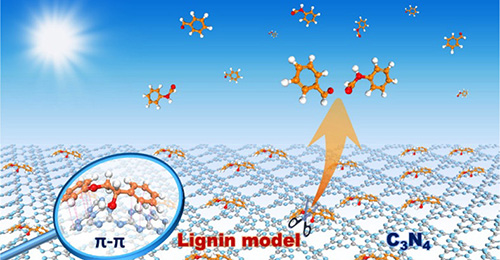
Huifang Liu, Hongji Li, Jianmin Lu, Shu Zeng, Min Wang, Nengchao Luo, Shutao Xu, Feng Wang*
ACS Catal., 2018, 8(6), 4761-4771
Photocatalysis is a potentially promising approach to harvest aromatic compounds from lignin. However, the development of an active and selective solid photocatalyst is still challenging for lignin transformation under ambient conditions. We herein report a mild photocatalytic oxidative strategy for C–C bond cleavage of lignin β-O-4 and β-1 linkages using a mesoporous graphitic carbon nitride catalyst. Identifications by solid-state NMR techniques and density functional theory (DFT) calculations indicate that π–π stacking interactions are most likely present between the flexible carbon nitride surface and lignin model molecule. Besides, low charge recombination efficiency and high specific surface area (206.5 m2 /g) of the catalyst also contribute to its high catalytic activity. Mechanistic investigations reveal that photogenerated holes, as the main active species, trigger the oxidation and C–C bond cleavage of lignin models.
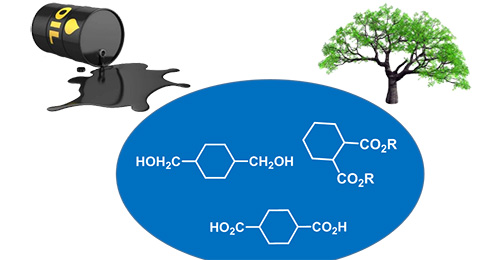
Yancheng Hu‡, Zhitong Zhao‡, Yanting Liu, Guangyi Li, Aiqin Wang, Yu Cong, Tao Zhang, Feng Wang*, Ning Li*
Angew. Chem. Int. Ed., 2018, 57(23), 6901-6905
Valuable polyester monomers and plasticizers—1,4‐cyclohexanedimethanol (CHDM), 1,4‐cyclohexanedicarboxylic acid (CHDA), and 1,2‐cyclohexanedicarboxylates—have been prepared by a new strategy. The synthetic processes involve a proline‐catalyzed formal [3+1+2] cycloaddition of formaldehyde, crotonaldehyde, and acrylate (or fumarate). CHDM is produced after a subsequent hydrogenation step over a commercially available Cu/Zn/Al catalyst and a one‐pot hydrogenation/oxidation/hydrolysis process yields CHDA, whereas 1,2‐cyclohexanedicarboxylate is obtained by a Pd/C‐catalyzed tandem decarbonylation/hydrogenation step.
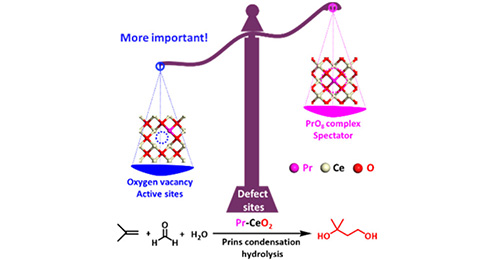
Zhixin Zhang, Yehong Wang, Jianmin Lu, Jian Zhang, Mingrun Li, Xuebin Liu, Feng Wang*
ACS Catal., 2018, 8(4), 2635-2644
Defect chemistries of metal-doped CeO2 catalysts have attracted extensive scientific interests in heterogeneous catalysis. Here, we report the structure–activity relationship of CeO2 catalysts doped ...
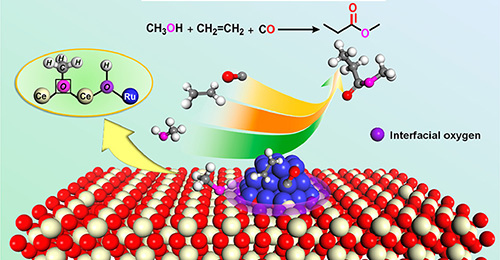
Jinghua An‡, Yehong Wang‡, Jianmin Lu, Jian Zhang, Zhixin Zhang, Shutao Xu, Xiaoyan Liu, Tao Zhang, Martin Gocyla, Marc Heggen, Rafal E. Dunin-Borkowski, Paolo Fornasiero, Feng Wang*
J. Am. Chem. Soc., 2018, 140(11), 4172-4181
The interface of metal-oxide plays pivotal roles in catalytic reactions, but its catalytic function is still not clear. In this study, we report the high activity of nanostructured Ru/ceria (Ru-cluste...
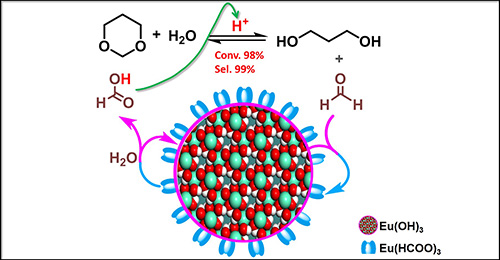
Yehong Wang, Jian Zhang, Zhixin Zhang, Tingting Hou, Chaofeng Zhang, Jinghua An, Feng Wang*
Green Chem., 2018, 20, 1455-1458
Herein, a strategy is developed for efficient production of 1,3-propanediol via the hydrolysis of 1,3-dioxane by the in situ transformation of the co-product formaldehyde (HCHO) in the presence of Eu(...
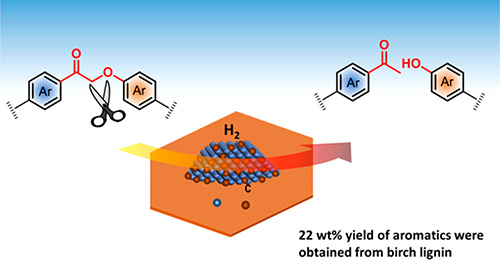
Min Wang, Xiaochen Zhang, Hongji Li, Jianmin Lu, Meijiang Liu, Feng Wang*
ACS Catal., 2018, 8(2), 1614-1620
Catalytic valorization of lignin is a sustainable way to provide aromatics for the human society, which depends on the electronic structure of catalytic sites. We herein report the preparation of a carbon-modified nickel catalyst via carbothermal reduction of Ni-doped layered double hydroxides. Lignosulfonate (LS), a lignin resource from the pulp industry, was used as a renewable carbon precursor. The carbon residues in the nickel surface layer changed the 3d electron distribution of nickel, whi
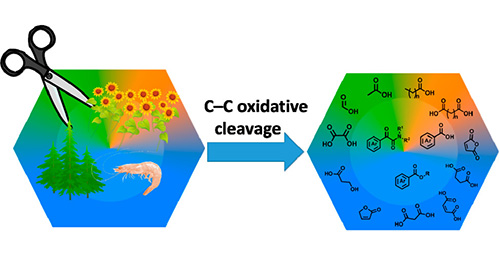
Min Wang, Jiping Ma, Huifang Liu, Nengchao Luo, Zhitong Zhao, Feng Wang
ACS Catal., 2018, 8(3), 2129-2165
The use of biomass as a resource has developed rapidly in recent years, and various kinds of chemicals could be produced from biomass. Although biomass is annually renewable and abundant, it is important to process it in the most efficient way. Before rushing into biomass conversion, it is necessary to consider what chemicals are reasonably and economically produced from biomass. In this Review, we first analyzed the products from biomass based on the structural properties and economics. Taking

Hongji Li, Min Wang, Huifang Liu, Nengchao Luo, Jianmin Lu, Chaofeng Zhang, Feng Wang*
ACS Sustainable Chem. Eng., 2018, 6(3), 3748-3753
Conversion of lignin to aromatic compounds via C–C/C–O bond cleavage has been an attractive but challenging subject in recent years. We herein report the first protocol that converts lignin models and preoxidized lignin to isoxazole and aromatic nitrile. The isoxazole motif is constructed by condensation of β-hydroxyl ketone with hydroxylamine. Magnesium oxide promotes an oximation reaction and an intramolecular condensation. Aromatic nitriles and esters are obtained via Beckmann rearrangement o

Chaofeng Zhang, Zhipeng Huang, Jianmin Lu, Nengchao Luo, Feng Wang*
J. Am. Chem. Soc., 2018, 140(6), 2032-2035
Generation of controllable carbon radical under the assistance of N-oxyl radical is an efficient method for the activation of C–H bonds in hydrocarbons. We herein report that irradiation of α-Fe2O3 and N-hydroxyphthalimide (NHPI) under 455 nm light generates phthalimide-N-oxyl radical (PINO*), which after being formed by oxidation with holes, is confined on α-Fe2O3 surface. The half-life time of the confined radical reaches 22 s as measured by in situ electron paramagnetic resonance (EPR) after